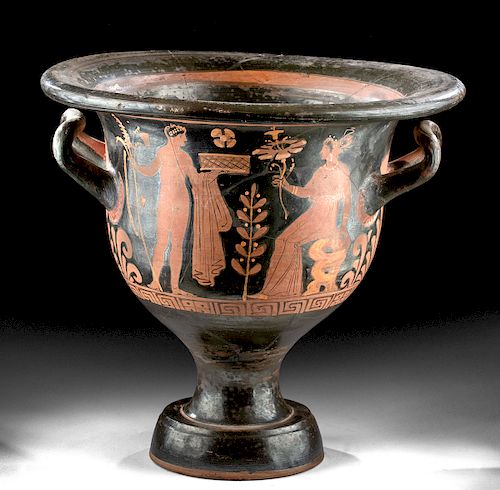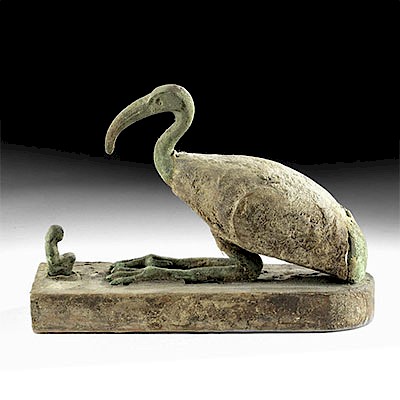Apulian Red Figure Bell Krater, ex-Royal Athena
Lot 41
About Seller
Artemis Gallery
686 S Taylor Ave, Ste 106
Louisville, CO 80027
United States
Selling antiquities, ancient and ethnographic art online since 1993, Artemis Gallery specializes in Classical Antiquities (Egyptian, Greek, Roman, Near Eastern), Asian, Pre-Columbian, African / Tribal / Oceanographic art. Our extensive inventory includes pottery, stone, metal, wood, glass and textil...Read more
Estimate:
$7,000 - $9,000
Absentee vs Live bid
Two ways to bid:
- Leave a max absentee bid and the platform will bid on your behalf up to your maximum bid during the live auction.
- Bid live during the auction and your bids will be submitted real-time to the auctioneer.
Bid Increments
| Price | Bid Increment |
|---|---|
| $0 | $25 |
| $300 | $50 |
| $1,000 | $100 |
| $2,000 | $250 |
| $5,000 | $500 |
| $10,000 | $1,000 |
| $20,000 | $2,500 |
| $50,000 | $5,000 |
| $100,000 | $10,000 |
| $200,000 | $20,000 |
About Auction
By Artemis Gallery
Oct 31, 2019
Set Reminder
2019-10-31 10:00:00
2019-10-31 10:00:00
America/New_York
Bidsquare
Bidsquare : Fine Antiquities, Asian, Ethnographic Art
https://www.bidsquare.com/auctions/artemis-gallery/fine-antiquities-asian-ethnographic-art-4581
Our Halloween Day auction features classical antiquities, ancient and ethnographic art from cultures encompassing the globe, plus fine art. Artemis Gallery info@artemisgallery.com
Our Halloween Day auction features classical antiquities, ancient and ethnographic art from cultures encompassing the globe, plus fine art. Artemis Gallery info@artemisgallery.com
- Lot Description
Magna Graecia, Southern Italy, Apulia, ca. 350 to 300 BCE. An enormous Apulian bell krater (wine mixing vessel), its generous surface area extensively painted via the red-figure technique with added fugitive yellow pigment. Side A features a charming scene depicting a seated maenad, draped in a diaphanous garment pinned at the shoulders, bedecked with bracelets, a beaded necklace, drop earrings, and ribbons with a kekryphalos adorning her attractive swept up coiffure. She sits upon a rocky outcrop in composite profile so as to reveal her frontal torso, and holds an enormous flower in her right hand. Facing her is a standing male, nude save a laurel wreath in his curly coiffure and a himation draped over his outstretched left arm. He presents a large pyxis in his left hand while holding a thyrsus in his right. The details of his anatomy, the drapery folds of the maenad's garment, and both figures' facial features are skillfully delineated with fine-line brushwork. Size: 12.75" in diameter x 11.875" H (32.4 cm x 30.2 cm)
Side B features two draped youths facing one another in profile, one holding a walking stick. In addition to this figural iconography, the decorative program is quite impressive, featuring stylized composite palmettes beneath each handle, frets surrounding the handle terminals, a grand laurel leaf garland adorning the underside of the rim, and a register of Greek key (meander) with periodic dotted checkerboard motifs below the figural scenes and palmettes.
Perhaps the most exciting innovation in Greek vase painting was the red-figure technique, invented in Athens around 525 BCE and beloved by other artists of Magna Graecia. The red-figure technique allowed for much greater flexibility as opposed to the black-figure technique, for now the artist could use a soft, pliable brush rather than a rigid metal graver to delineate interior details, play with the thickness of the lines, as well as build up or dilute glazes to create chromatic effects. The painter would create figures by outlining them in the natural red of the vase, and then enrich these figural forms with black lines to suggest volume, at times perspectival depth, and movement, bringing those silhouettes and their environs to life. Beyond this, fugitive pigments made it possible for the artist to create additional layers of interest and detail, as we see in this example.
Provenance: private Alabama, USA collection; ex-Roy Green collection; ex-Royal-Athena Gallery, New York, USA; ex-collection of Professor Alcibiades N. Oikonomides (c. 1988), Chicago (Classics professor at Loyola University), acquired in the 1970s; ex-private M.B. collection, Westlake Village, California, USA
All items legal to buy/sell under U.S. Statute covering cultural patrimony Code 2600, CHAPTER 14, and are guaranteed to be as described or your money back.
A Certificate of Authenticity will accompany all winning bids.
We ship worldwide and handle all shipping in-house for your convenience.
#148709Professionally repaired from multiple pieces with restoration over the break lines. Normal surface wear with scuffs commensurate with age, but the iconographic and decorative programs are still quite strong. What's more, the black glazed areas have developed an amazing silvery patina.Condition
- Shipping Info
-
All shipping is handled in-house for your convenience. Your invoice from Artemis Gallery will include shipping calculation instructions. If in doubt, please inquire BEFORE bidding for estimated shipping costs for individual items.
-
- Buyer's Premium



 EUR
EUR CAD
CAD AUD
AUD GBP
GBP MXN
MXN HKD
HKD CNY
CNY MYR
MYR SEK
SEK SGD
SGD CHF
CHF THB
THB
















